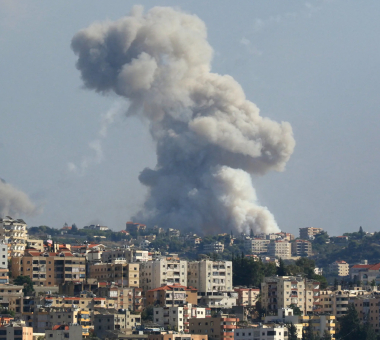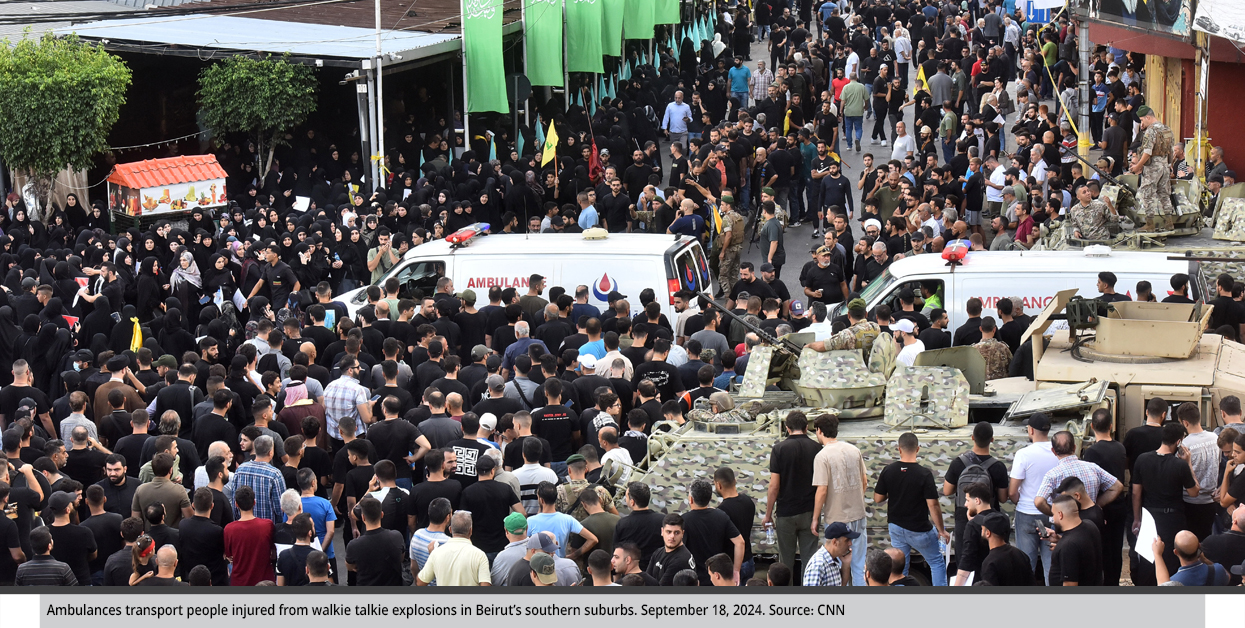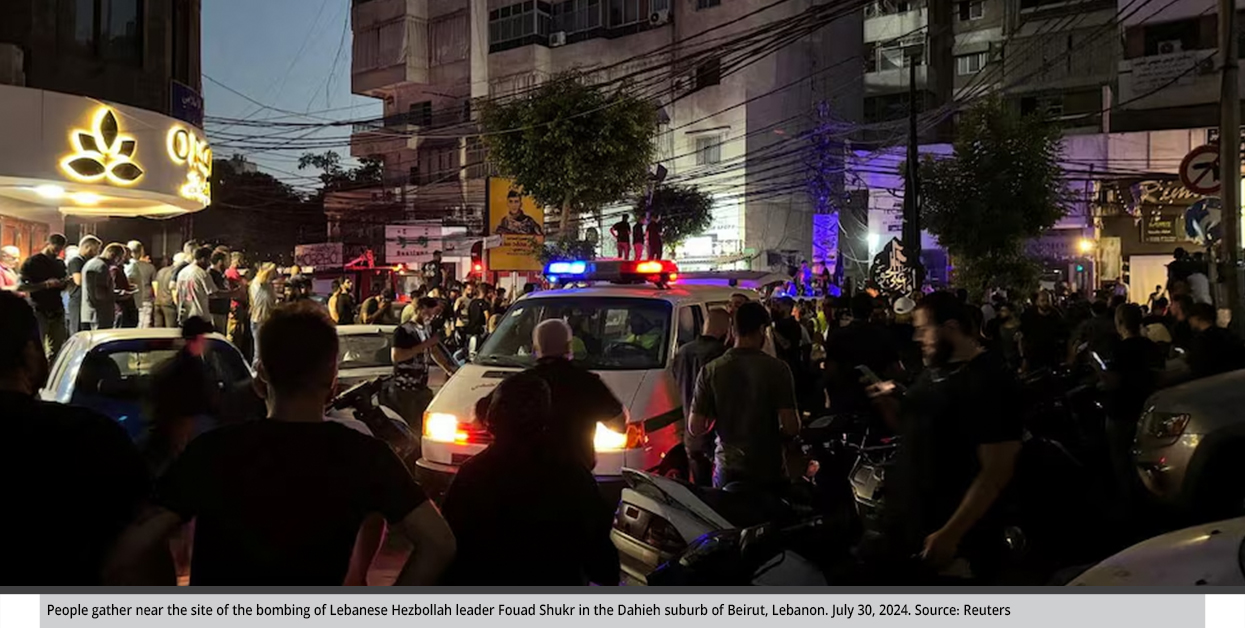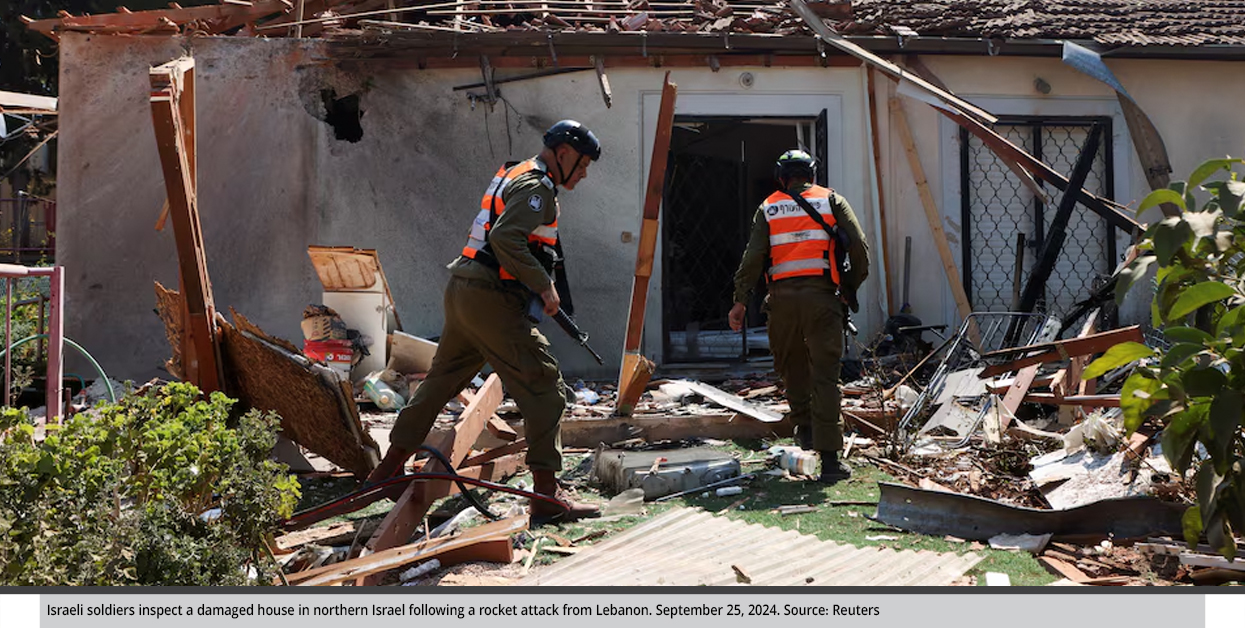Intelligence Superiority Places the Escalation Between Israel and Hezbollah at a Turning Point
Israeli information and intelligence superiority has contributed to its deadly aim in striking several strategic targets of the Hezbollah Movement, both at its leadership and infrastructure. This paper seeks to analyze the Israeli strategy towards Hezbollah before and after the war in Gaza, which has significantly weakened the Movement’s capabilities and hindered its ability to respond proportionately and escalate in return.
by STRATEGIECS Team
- Release Date – Sep 25, 2024

The confrontations between Israel and Hezbollah are entering a new phase that transcends the threshold of limited escalation or the established rules of engagement since the outbreak of the war in Gaza. Both sides are now engaged in a gradual escalation that threatens to explode into the open war, that regional and international actors have warned for the past 11 months is one of the worst scenarios for the region. However, previous confrontations revealed aspects of these clashes, particularly Israel’s intelligence superiority contrasting sharply with Hezbollah’s diminished response to what has been the most unprecedented Israeli escalation since 2006.
This suggests a distortion in the deterrence balance between the two, impacting the current gradual escalation and various actors within the"Resistance Axis and the “unity of arenas” strategy. Understanding these recent developments necessitates revisiting the Israeli strategy towards Hezbollah and Iran prior to the Gaza war, which significantly weakened Hezbollah’s capabilities and exposed it to Israel, providing insights into the gradual escalation between the two.
The Israeli Campaign Between Wars
After the war with Hezbollah in 2006, Israel formulated a defensive, preemptive, and preventive strategy known as the “Campaign Between Wars.” This conflict, along with the losses Israel suffered and the threats posed by Hezbollah on various levels, marked a turning point in Israel’s strategic thinking regarding Hezbollah and the risks associated with Iranian influence, including its nuclear and missile programs, as well as its network of proxies that, after 2012, formed a strategic encirclement extending from Iraq to Syria, then Lebanon, reaching the Mediterranean Sea, alongside Yemen in the Red Sea.
This hybrid form of threats forced Israel to make a significant change in its defense doctrine, shifting the focus from operational aspects to achieving superiority in intelligence, information, and advanced ground operations. This strategy was built on the findings of Israel’s Winograd Commission, which investigated the 2006 war and revealed pressures within the military, including unpreparedness, inadequate strategic and operational planning, an increasing reliance on air force, and a weakness in ground forces in achieving war objectives in a complex operational environment.
The “Campaign Between Wars,” also called ‘The War Between the Wars,” emerged as an evolution in how Israel confronts hybrid challenges at its borders, representing a practical expression of preparedness for war against Iran and its proxies, particularly Hezbollah. It fundamentally relies on joint operations between intelligence units, the air force, and the army, intensifying intelligence activities to obtain accurate information that can then be transformed into surgical military operations when necessary.
This approach targets everything Israel categorizes as a strategic threat, whether related to Iran’s nuclear and missile programs, Iranian positioning in Syria, or even Syrian chemical and biological weapons. Since 2015, Israel has had a clear focus on Hezbollah, especially in preventing the delivery of advanced weapons from Iran through Syria that would disrupt the balance of power between Syria and Israel, adding operational complexities for Israel during major war campaigns between the two. This includes Hezbollah acquiring air defense systems that constrain Israeli air operations in Lebanese airspace and enhancing its arsenal of precision weapons capable of striking strategic military and civilian facilities. Israel considers these developments a significant change in the rules of game and a strategic threat.
In contrast to Israel’s experience in the 2006 War with Hezbollah, the Campaign Between Wars has been executed with minimal losses and without the risk of Israel being drawn into war or facing retaliatory strikes. Hezbollah did not consider the Israeli attacks on its elements and positions in Syria as violations of its red lines in Lebanon. In 2023, Israeli strikes against Hezbollah in Syria constituted 24% of the total strikes, with 5% targeting arms transfer operations and 24% aimed at Iranian targets. Hezbollah did not respond to any of them.
However, measuring the effectiveness of this campaign is not only about these tactical aspects but also about its contribution to establishing a high-quality intelligence infrastructure against Hezbollah and Iran. It seems to have enhanced Israel’s capabilities to recruit high-level agents within their networks, increased its understanding of the relationship between Hezbollah and Iran, and uncovered and allowed monitoring of supply chains for weapons and military equipment to the Hezbollah. Additionally, the role of technology has supported Israeli intelligence operations in the air, espionage, and intercepting communications, among other capabilities.

Undermining the Initiative of Hezbollah and Iran
Joint operations between Israeli intelligence units and the military have continued against Hezbollah and Iran following the outbreak of the war in Gaza. This has become a familiar aspect of Israel’s operations against Hezbollah and various actors in the Resistance Axis since Hezbollah’s initial involvement in the escalation on October 8, 2023. In addition to maintaining its objectives of preventing Hezbollah from acquiring weapons and limiting Iran and its proxies’ presence in Syria, Israel targeted Aleppo and Damascus airports three times between October 14 and 22.
Israel has added a new layer to its objectives by preventing Lebanon from becoming a second front alongside the primary war front in Gaza. This led Israel to deploy part of its reserve forces along its northern borders and respond to Hezbollah’s attacks, working to weaken its capabilities and thwart its plans to launch military surprises against Israel. The strategy involves intensifying surgical military operations, leveraging the accumulated knowledge and information gathered over decades of implementing the Campaign Between Wars. In the initial months of the war, Israeli tactics focused on high-value targets to achieve two main pillars.
- Limiting the Relationship Between Iran and Hezbollah and Iran’s Capacity to Support Hezbollah
This has been executed by targeting Iranian leaders responsible for communication, logistical, and intelligence support between Iran and Hezbollah, particularly in Syria. Local organizations have recorded over 100 Israeli attacks in Syria, resulting in the deaths of 27 IRGC commanders, including 14 high-ranking officials, and 51 members of Hezbollah including:
1- Mohammad Ali Ataei Shourjeh, an advisor in the "Resistance Axis," and Bana Taqizadeh, an expert in the airspace unit of the IRGC, were killed in a missile attack in the Sayyida Zainab area on December 2, 2023.
2- Razi Mousavi, responsible for coordinating Iranian proxies in Syria and transferring Iranian weapons through Syria to Lebanon, was killed in a missile strike in the Sayyida Zainab area on December 25, 2023.
3- Hojjatollah Amidvar, an intelligence officer in the IRGC and Quds Force, was killed along with other leaders, including Aghazadeh, Hosseini Mohammadi, Saeed Karimi, and Mohammad Amin Samadi, in an air raid targeting a building in Damascus on January 20, 2024.
4- Saeed Alidadi, head of the communications unit in the IRGC, was killed in an airstrike while supervising the transfer of a weapons shipment headed for Hezbollah, according to local sources, on February 2, 2024.
5- Behrouz Vahedi, an officer in the communications unit of the Quds Force, and his assistant were killed on March 26, 2024.
6- The death of Mohammad Reza Zahidi, commander of the IRGC in Syria, Lebanon, and Palestine, along with six other leaders, occurred during the bombing of the Iranian consulate in Damascus in early April 2024.
7- Ahmad Reza Afshari, a military advisor in the IRGC Aerospace Force, was killed in an airstrike in Syria on August 26, 2024.
- Creating a Gap at the Level of First-Line Leaders of Units Tasked with Operations in Southern Lebanon
These units—Aziz, Badr, and Nasr—are responsible for the three military fronts in southern Lebanon: western, central, and eastern. Israel has assassinated most of the first-line leaders of these military units within the Hezbollah, including:
1- January 8, 2024: Wisam Al-Tawil, commander of the Redwan Unit responsible for military operations in southern Lebanon.
2- June 12, 2024: Sami Taleb, commander of the Nasr Unit responsible for operations in the central area of the border strip with Israel in the southn.
3- July 3, 2024: Mohammad Ni’mah, commander of the Aziz Unitresponsible for artillery and drones.
4- August 7, 2024: A group of Hezbollah leaders responsible for securing the advance of these units and conducting strikes and targeting operations inside Israel, including Hassan Faris, commander of Hezbollah’s anti-tank missile unit.
Achieving Shock at Various Levels
The dynamics of escalation between Israel and Hezbollah notably evolved after mid-June 2024, especially as the war in Gaza entered a new, less intense phase. Given the difficulties in reaching a ceasefire agreement in Gaza, Israel’s focus shifted to decisively addressing the escalations in the northern front , reallocating its military effort and resources to avoid finding itself in an open, multi-front war that could last for years.
Israeli actions took on a new dimension following the announcement of the general cessation of operations in Gaza on August 16, 2024. Israel developed new methods and targets aimed at resolving the escalation with Lebanon through strikes on various leadership, operational, and functional levels within Hezbollah, as well as neutralizing communication pathways and launching psychological warfare against Hezbollah and its supportive environment.
At the leadership level, Israel assassinated Fuad Shukr, the head of operations for Hezbollah, on July 31, 2024, by targeting a building in the Beirut suburb of Dahieh. Two months later, Israel also assassinated Ibrahim Aqil, the head of the movement’s operations department and commander of its Redwan Force, along with the entire senior leadership of the force in an airstrike targeting a meeting in Dahieh on September 20, 2024. Meanwhile, Ali Al-Kurki, the third-ranking official in the Hezbollah Movement, survived an attack on September 23, while Ibrahim Qabisi, commander of its missile system, was assassinated on September 24, 2024.
This series of assassinations likely compelled the remaining members of the leadership structure, particularly Hezbollah’s secretary-general, to adopt heightened security measures that could limit oversight and coordination with all field data.

- At the Operational Level
The explosions of the beepers and walkie talkies in the hands of Hezbollah members on September 17 and 18 resulted in more than 3,500 injuries, and according to the Lebanese Minister of Health, 39 deaths. Most of those affected by the explosions were Hezbollah members, particularly field commanders and liaison officers, who were then neutralized from participating in the escalation, , leading to a loss of communication not only within Hezbollah but also between its members and Iran.
- At the Psychological Level
Israel’s preemptive strike against Hezbollah’s plans to retaliate for the killing of Fuad Shukr on August 25, followed by the unprecedented breach of Hezbollah through the explosions of their beepers and walkie talkies, created a shockwave that rocked Hezbollah. Secretary-General Hassan Nasrallah admitted this psychological dimension in a speech on September 19, 2024: “Hezbollah received a strong blow from Israel.”
In fact, Israeli tactics since the outbreak of the war on October 7 have followed a series of interconnected measures.
1- The increasing assassinations of field leaders and unit commanders led Hezbollah to reduce its reliance on modern communication methods and revert to analog devices such as beepers and telephone landlines. According to security sources, Hezbollah, considering them older and thus safer from espionage and tracking attempts, had distributed the beepers only hours before they were detonated.
2- The assassinations of the trio of unit leaders in southern Lebanon increased the involvement of operational commanders in coordinating tasks to compensate for the leadership gap, which heightened their movements in the field and increased their meetings with lower-ranking leaders, making them more vulnerable to infiltration and assassination.
3- The explosion of beepers and walkie talkies undermined Hezbollah’s confidence in using any imported or electronic communication devices, prompting operational leaders to meet face-to-face with their units, which allowed Israel to target the leadership structure of the Redwan Unit during a meeting described as rare.”
4- The explosions also enabled Israel to uncover the activities of various Hezbollah members and their locations, as well as several strategic Hezbollah locations. This new information was added to Israel’s target bank against Hezbollah, which included an announcement of attacking 1,600 Hezbollah targets in 200 areas in Lebanon on September 24 alone.
- Transition to Gradual Escalation
The recent Israeli measures primarily aimed to expand the level of escalation for Israel while narrowing Hezbollah’s response space and margin for maneuvering, pushing it to exclude the option of war to prevent a worsening of its security and military capabilities. Thus far, Hezbollah remains hesitant to declare war.
Despite this, Israel treats Lebanon as a war front, having intensified its airstrikes and expanded its geographical range since September 22 from southern Lebanon to the Bekaa Valley and the Beirut suburb of Dahieh of Beirut. These strikes targeted open areas and residential neighborhoods, resulting in more than 600 deaths and nearly 3,000 injuries, along with strikes on Hezbollah’s infrastructure, including rocket launch pads and weapons storage facilities, with a significant focus on Dahieh, considered the Hezbollah’s stronghold in Lebanon.
In response, Hezbollah has engaged in limited geographical confrontations with specific exceptions, intensifying its attacks on the Golan Heights and Upper Galilee, while focusing on Israeli military installations such as the Ramat David Air Base and the Rafael company in Haifa.

Finally, the unprecedented Israeli escalation against Hezbollah presents the scene with three possible paths.
Path One: Establishing a Security Belt or Buffer Zone
The Israeli escalation primarily aims to separate the Lebanon front from the Gaza Strip. Israeli military pressures on Hezbollah may lead the group to seriously consider American and French calls to implement UN Security Council Resolution 1701, potentially resulting in a ceasefire. This is especially relevant given that Israel’s intensive air campaign has imposed a new burden on Hezbollah, marked by the displacement of residents from southern cities and villages to central and northern Lebanon, with reports indicating that more than half a million people have left their homes.
On the other hand, there is a possibility that Israeli operations will move to a new phase, which may include a ground attack if Hezbollah maintains its position. This would establish a security belt and buffer zone that distances Hezbollah from the Israeli borders, allowing settlers to return to their settlements. This path is reinforced by the transfer of Israel’s 98th Commando Division from the Gaza Strip to the northern front command, and the army’s announcement on September 25 of calling up two reserve brigades to the northern front.
However, such a step, if not followed by a diplomatic course, could risk dragging Israel into a prolonged war of attrition, especially since the strikes against Hezbollah and its leaders will not prevent Hezbollah from continuing its engagements with Israel, particularly if it has forces inside Lebanon.
Path Two: Continuing the War Until a Decisive Outcome Against Hezbollah
The ongoing Israeli escalation against Hezbollah for more than a month, along with clear signs of Hezbollah’s inability to respond similarly or match the escalation and inflict losses on Israel, may drive Israel to continue the war to destroy its target bank. This could lead to a strategic decisive outcome in Lebanon, undermining Hezbollah’s capabilities, damaging its relations with Iran, and ending previous deterrent equations. In this path, Israeli strikes against the Hezbollah could continue for months, but at some point, this may lead Iran and its proxies to expand their involvement in the war, especially as Iraqi armed factions have recently intensified their targeting of Israel, with a drone strike hitting a monitoring base belonging to the Golani Brigade on September 23, 2024.
Path Three: Absorbing the Shock and Restoring the Hezbollah’s Deterrence
Hezbollah may undertake qualitative military operations against strategic targets in Israel. Despite logistical and security difficulties and the absence of some of its leaders, it still retains a significant portion of its military capabilities and its ability to deliver precise strikes against military targets. Cells within the Hezbollah, comprising elite members below the leadership level, are capable of planning and directing covert operations using the Hezbollah’s capabilities either inside Lebanon or outside. Such operations could involve drones, missiles, or precision weapons, or it could utilize different methods such as planting explosives in Israel, as occurred previously in the Megiddo junction incident or the explosive device planted by a Hezbollah cell in Tel Aviv’s Yarkon Park, which aimed to assassinate former Israeli Defense Minister Moshe Ya’alon, as revealed by the Israeli site Walla.

STRATEGIECS Team
Policy Analysis Team
 العربية
العربية